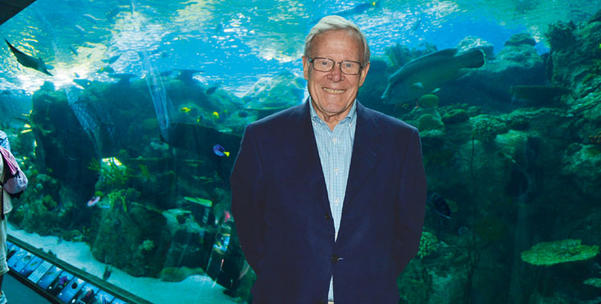
Throughout the country and the world, aquariums serve as places where people gather to learn about the world’s waters and the life within them. But in Long Beach, Aquarium of the Pacific President and CEO Dr. Jerry Schubel has a more far-reaching vision for the nonprofit institution, one that places it at the forefront of environmental outreach and education to inform communities and effect change.
“I think once we open Pacific Visions in the spring of 2019, that’s going to be the most powerful platform in the world for letting people explore alternative pathways to the future and to discover what we need to do to live in harmony,” Schubel said, referring to the planned new wing of the Aquarium. “You don’t do it by preaching, and you don’t do it with all these films that are gloom and doom. It’s a message of hope and creativity and innovation.”
The wing’s centerpiece will be the 300-seat Honda Pacific Visions Theater, which will screen original documentaries and films produced by the Aquarium, the storylines of which are currently being refined. Also included in plans for the wing are an expanding, changing exhibit gallery and an art gallery.
“Now we have a partner, Cortina Productions. And they will do most of the production of this,” Schubel said of the documentaries. Cortina Productions has created programs for the Smithsonian National Museum of African American History and Culture, multiple presidential libraries (including those of George W. Bush and Richard Nixon), the Newseum, and many other historical and cultural institutions. “They are among the best storytellers in the world, and they are our partners. So we know the content, but they can add the magic,” Schubel said.
In Pacific Visions, Schubel plans to educate visitors about potential solutions for and approaches to becoming resilient to climate change and improving the environment.
“It’s very clear that this addition is not traditional [for an] aquarium. There will be very few fish in it. . . . We want to tell the big story. And fish aren’t very good storytellers,” Schubel said.
“No matter how quickly we reduce greenhouse gas emissions – and we must – we’re going to live in a different world long before this century is over. And it will be a warmer world, a higher stand of sea level. There will be more frequent storms. Agricultural productivity [will go] down,” he said, adding that this picture could make people depressed. “On the other hand, you can look at it [as] what a wonderful opportunity.”
Because of Long Beach’s size and its assets – the beach, the port, the airport, et cetera – Schubel believes it is positioned to become a model of climate resiliency, with some help from the Aquarium.
“It has to be a city that embraces creativity and innovation, dealing with the new challenges that we have,” Schubel said. “I would like to think that we could be a leader in developing, refining and testing what are called ‘living shorelines,’ using oyster beds, mussel beds, seagrass beds to help protect the shoreline against storm surges and erosion.” Schubel said he has had preliminary discussions with new Long Beach Harbor Commissioner Frank Colonna on this topic.
Schubel is also an advocate for pursuing the development of aquaculture in federal waters off the California coast. “Farming fish in the sea, and particularly in federal waters, is a great opportunity for Southern California and I think it extends to Long Beach,” he said.
“With Long Beach, the big issues are drought – there will be more demands on fresh water in the future. And I think also air quality is going to be a big issue,” Schubel said. “I would like to think that Long Beach and the Aquarium can open people’s eyes. The traditional approaches to conservation often aren’t going to work in the future, so we have to challenge our own thinking.”
Through programming at the Aquarium and within its new wing, Schubel hopes to educate the public about upcoming challenges and opportunities to address them, from developing biodiesel for use in trucks to creating natural segments of the Los Angeles River to recognizing the role Long Beach’s existing businesses and institutions can play in the city’s future.
